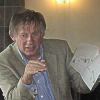Christopher Alexander

Christopher Alexander
Christopher Wolfgang Alexander is a widely influential architect and design theorist, and currently emeritus professor at the University of California, Berkeley. His theories about the nature of human-centered design have had notable impacts across many fields beyond architecture, including urban design, software, sociology and other fields. Alexander has also designed and personally built over 100 buildings, both as an architect and a general contractor...
NationalityAmerican
ProfessionArchitect
Date of Birth4 October 1936
CountryUnited States of America
The more living patterns there are in a place - a room, a building, or a town - the more it comes to life as an entirety, the more it glows, the more it has that self-maintaining fire which is the quality without a name.
When you make something, cleaning it out of structural debris is one of the most vital things you do.
Images in the 20th century had a unique power where image became divorced from reality, and often more important than reality. Buildings were judged more by the way they looked in magazines than by the satisfaction people felt when using them.
Everyone is aware that most of the built environment today lacks a natural order, an order which presents itself very strongly in places that were built centuries ago
The buildings that I build very often have a dreamlike reality. I don't mean by that they have a fantasy quality at all, in fact quite the reverse. They contain in some degree the ingredients that give dreams their power... stuff that's very close to us.
We must face the fact that we are on the brink of times when man may be able to magnify his intellectual and inventive capability, just as in the nineteenth century he used machines to magnify his physical capacity. Again, as then, our innocence is lost. And again, of course, the innocence, once lost, cannot be regained. The loss demands attention, not denial.
In my life as an architect, I found that the single thing which inhibits young professionals, new students most severely, is their acceptance of standards that are too low.
To work our way towards a shared language once again, we must first learn how to discover patterns which are deep, and capable of generating life.
The structure of life I have described in buildings - the structure which I believe to be objective - is deeply and inextricably connected with the human person, and with the innermost nature of human feeling.
People are deeply nourished by the process of creating wholeness.
Nowadays, the process of growth and development almost never seems to manage to create this subtle balance between the importance of the individual parts, and the coherence of the environment as a whole. One or the other always dominates.
Complexity is one of the great problems in environmental design.
From a sequence of these individual patterns, whole buildings with the character of nature will form themselves within your thoughts, as easily as sentences.
It is not possible to make great buildings, or great towns, beautiful places, places where you feel yourself, places where you feel alive, except by following this way. And, as you will see, this way will lead anyone who looks for it to buildings which are themselves as ancient in their form, as the trees and hills, and as our faces are.